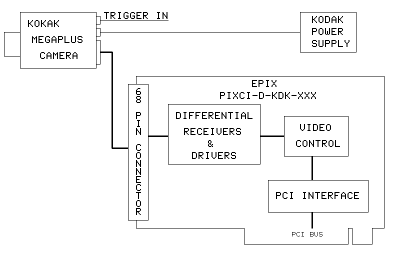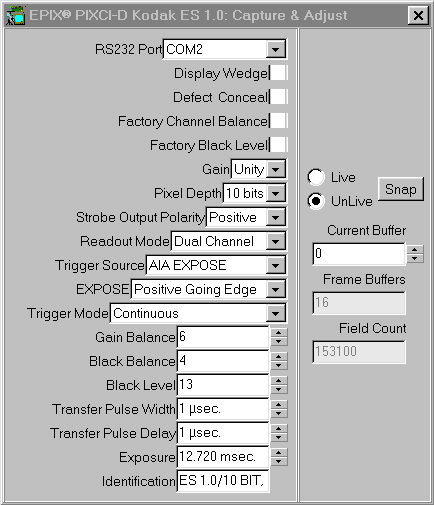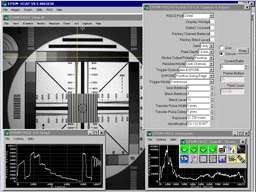
PIXCI® D PCI Bus Interface for Redlake MASD MEGAPLUS Cameras

|
| INNOVATIONS |
|
TRANSFER 10 BIT PIXELS TO THE PCI BUS FOR $995 (US).
The PIXCI® D image transfer board receives 10 bit or 8
bit pixel data, in single or dual channel mode, from a Redlake MASD MEGAPLUS
camera and, as a PCI bus master, transfers it to the host computer's
motherboard memory or a PCI bus target. Imaging applications which
were once restricted to custom image processing hardware, or limited
by expensive image memory, can now be performed by the PIXCI® D
board, EPIX imaging software, a MEGAPLUS camera, a Pentium processor,
and a PCI bus motherboard. The PIXCI® D maximizes the use
of the PCI bus to minimize the cost of interfacing a Redlake MASD MEGAPLUS
digital camera to a computer.
IMAGE TRANSFER TO THE PCI BUS
The PIXCI® D uses the Redlake MASD MEGAPLUS pixel clock to acquire
camera video data. It buffers the pixel data when the PCI bus is
busy and transfers buffered pixel data at rates up to 132 megabytes
per second to the PCI bus. Pixel data may be transferred to motherboard
memory or to a PCI bus target.
VIDEO CAPTURE AND CAMERA CONTROL
The PIXCI® D has a programmable video window to capture
image data from a Redlake MASD MEGAPLUS digital camera. The video window
can be as large as the KAF-16800's 4096 pixels by 4096 lines or
as small as 8 pixels by 8 lines. Camera control hardware and software
is provided for triggered capture, integration, and control of the
camera's serial port. Camera integration can be programmed from
microseconds to minutes.
VIDEO DISPLAY
Image display is provided by the host computer's video graphics
adapter (VGA) and monitor(s) or flat panel(s). Display resolution
is a function of the capabilities of these devices. A software look-up-table
allows display of 8 bits from cameras with 10 bits of gray level.
With a fast Pentium processor and an Advanced Graphics Port VGA,
10 bit images can be captured and displayed at the camera's frame
rate.
XCAP is a ready-to-run interactive image processing and analysis program for qualitative and quantitative image operations running on Win95 and NT. A few mouse clicks select FFTs, histograms, morphology, measurements, edge detection, correlations, arithmetic operations, blob analysis, and many other functions. XCAP controls up to 8 PIXCI® D boards in one computer.
XCOBJ board control programming libraries and PXIPL image processing libraries allow application-specific code to be added to the large selection of functions already developed. Example code for image processing is included. No royalties are required for software developed using these libraries.
SOLUTIONS and SUPPORT
EPIX, Inc. has provided imaging solutions and support for OEM machine
vision manufacturers and engineers since 1984.
FEATURES

TRIGGER IN and EXPOSE Timing Diagram

The DIFFERENTIAL RECEIVERS & DRIVERS convert data from differential to single ended TTL signals. Differential signals are used to provide improved noise reduction over single ended TTL signals.
The VIDEO CONTROL is used for image data formatting, video windowing, camera EXPOSE control, trigger conditioning and control, and buffering of data from the differential receivers to the PCI interface. The VIDEO CONTROL provides the video format for a Redlake MASD MEGAPLUS camera.
The PCI INTERFACE provides interrupt generation, PCI configuration registers, first-in and first-out buffers, and PCI bus master and target control.
TRIGGER IN and EXPOSE signals are not required when the camera is operating in a continuous readout mode. TRIGGER IN is an input to the camera, but can also be connected to the PIXCI® D. EXPOSE is an output from the PIXCI® D to the camera.
TRIGGER IN can be used to cause the camera to acquire an image. If the trigger signal is connected to the PIXCI® D, the PIXCI® D will send the EXPOSE signal to the camera for a period that can range from microseconds to minutes. This mode provides a wider range of control of the exposure time of the camera than is provided by the camera's internal exposure control.
 The XCAP Camera Control window provides RS-232 control of the camera's
operating mode, black level, gain, channel balance, defect concealment,
pixel depth, strobe output, readout mode, trigger source, and test
wedge. The specific modes available for each camera model are supported.
After changes are made to the camera's configuration, XCAP adjusts
the video parameters to capture the correct size image and to provide
required control signals. The camera control window is shown at
right.
The XCAP Camera Control window provides RS-232 control of the camera's
operating mode, black level, gain, channel balance, defect concealment,
pixel depth, strobe output, readout mode, trigger source, and test
wedge. The specific modes available for each camera model are supported.
After changes are made to the camera's configuration, XCAP adjusts
the video parameters to capture the correct size image and to provide
required control signals. The camera control window is shown at
right.

SPECIFICATIONS
| Resolution Pixels: 8 to maximum pixels per line of camera. Lines: 8 to maximum lines per image of camera. Capture Window Frame Rate Bus Requirements
Connector
|
Signal Input and Output
REQUIREMENTS Display - XCAP
Display - XCOBJ
Motherboard |
